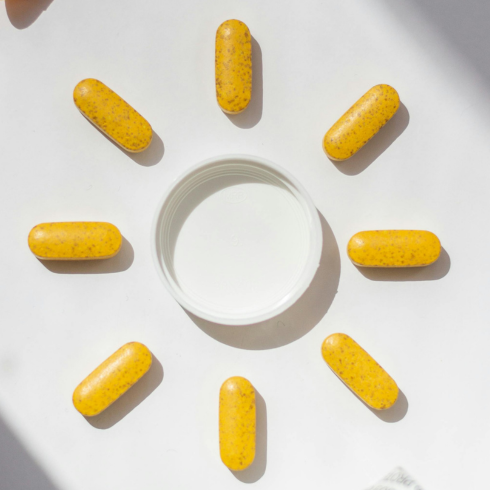The Importance of Vitamin D for Health
TABLE OF CONTENTS
ALL ABOUT VITAMIN D
Vitamin D is one of the few nutrients that the body can both absorb through food and produce on its own. Unlike many other vitamins, it is fat-soluble, meaning it dissolves in fats and can be stored in the body’s tissues.
Its natural production is triggered when the skin is exposed to sunlight—specifically to UVB rays. This direct connection with sunlight has earned it the nickname “the sunshine vitamin.”
There are two main forms of vitamin D:
- Vitamin D2, also known as ergocalciferol, is found in certain plant-based foods, particularly mushrooms that have been exposed to ultraviolet light.
- Vitamin D3 (cholecalciferol), which the body naturally produces from cholesterol under UVB exposure, is also found in animal-based foods such as fatty fish.
Vitamin D3 is generally considered more effective than D2 at maintaining optimal blood levels of vitamin D because it is better absorbed and remains active in the body for longer.
Once vitamin D is absorbed or produced by the skin, it only becomes active after a transformation process. This occurs in two stages: first in the liver, then in the kidneys, where it is converted into the active form known as calcitriol.
This active form plays a role in many biological processes. The most well-known function of vitamin D is its ability to facilitate the absorption of calcium and phosphorus in the intestines—two key elements for healthy bones and teeth.
But its benefits go far beyond that. Vitamin D also contributes to:
- the proper functioning of the immune system;
- the maintenance of muscle strength;
- and the prevention of certain chronic imbalances related to age or lifestyle.
In children, it is essential for bone growth and for preventing rickets. In adults, it helps reduce the risk of bone density loss, such as in osteoporosis.
GENERAL QUESTIONS ABOUT VITAMIN D
Vitamin D is often considered an essential nutrient for overall well-being, at any age. While it’s best known for its role in bone health, its benefits go far beyond that. Here’s an overview of the most frequently asked questions about vitamin D.
What is the role of vitamin D?
The main function of vitamin D is to promote the absorption of calcium and phosphorus in the intestines. These minerals contribute to the development and strength of bones and teeth. Without vitamin D, even a calcium-rich diet isn’t enough to maintain healthy bones.
Vitamin D also plays a role in the following functions:
- the proper functioning of the immune system;
- muscle contraction;
- nerve signal transmission;
- normal cell division.
It is therefore essential not only for bone growth and strength but also for maintaining vitality and overall health.
How does vitamin D benefit the body?
Vitamin D contributes to many aspects of health. Its main benefits include:
- Strengthening the immune system: it helps regulate natural defenses and may reduce the risk of certain infections.
- Preventing osteoporosis: it helps limit bone density loss, particularly in older adults or postmenopausal women.
- Supporting muscle health: it helps prevent falls in seniors by maintaining muscle strength.
- Reducing risk of chronic diseases: studies suggest a link between healthy vitamin D levels and a lower risk of type 2 diabetes, cardiovascular diseases, or autoimmune disorders.
- Improving mental well-being: adequate vitamin D levels may also help prevent depression, particularly seasonal affective disorder.
Where is vitamin D naturally found?
There are three main sources of vitamin D:
- Sun exposure: this is the most natural source. About 15 to 30 minutes of exposure to the arms, face, and legs several times a week is usually enough—provided the skin is unprotected by sunscreen and sunlight exposure is adequate.
- Food: the richest sources of vitamin D are fatty fish (salmon, mackerel, sardines, herring), cod liver, egg yolks, UV-exposed mushrooms, and fortified foods (milk, orange juice, cereals).
- Supplements: these are often necessary in winter, for the elderly, infants, or people who get little sun exposure.
What is the difference between D2 and D3?
Vitamin D exists mainly in two forms:
- Vitamin D2 (ergocalciferol): plant-based, produced by certain fungi or yeasts. It’s less effective at raising and maintaining vitamin D levels in the blood.
- Vitamin D3 (cholecalciferol): animal-based (found in fish liver oil, lanolin) or produced by the skin when exposed to sunlight. It’s more stable and better absorbed by the body.
Most supplements today use vitamin D3, as it’s more effective in correcting deficiencies.
How long should you stay in the sun to produce enough vitamin D?
The required exposure time depends on many factors: season, time of day, latitude, skin color, age, and surface area exposed. In general:
- In summer: 10 to 30 minutes of direct sun exposure without sunscreen, 2 to 3 times per week, is usually sufficient.
- In winter: in temperate regions like Northern Europe or Belgium, sunlight is often insufficient between October and March. It’s therefore difficult to produce enough vitamin D naturally, which often makes supplementation necessary.
It’s important to note that excessive sun exposure carries risks (skin aging, skin cancer). Finding a healthy balance between vitamin D needs and skin protection is essential.
VITAMIN D DEFICIENCY
Vitamin D is essential for many vital functions, and when it becomes deficient, the body can feel the effects in subtle but significant ways. Vitamin D deficiency is now recognized as a major public health concern, especially in regions with limited sunlight exposure or among vulnerable groups. Understanding the signs, causes, and consequences of this deficiency helps to take effective action.
How does a vitamin D deficiency manifest?
A lack of vitamin D may go unnoticed at first, as the symptoms are often mild and nonspecific. However, certain signs can serve as warnings:
- Persistent fatigue or unexplained lack of energy.
- Diffuse muscle or joint pain.
- Muscle weakness, especially in the legs.
- Bone fragility or frequent fractures in adults.
- Mood disorders, such as a tendency toward depression, particularly in winter.
- Recurring infections due to a weakened immune system.
- In children, severe deficiency can cause growth problems or bone pain linked to rickets.
What causes vitamin D deficiency?
Several factors can lead to insufficient vitamin D levels:
- Lack of sun exposure: living in less sunny regions, staying indoors frequently, or wearing covering clothing limits the body’s natural production of vitamin D through the skin.
- Excessive use of sunscreen: while essential for skin protection, it also blocks UVB rays, which are necessary for vitamin D synthesis.
- Poor diet: few foods naturally contain vitamin D, and diet alone often cannot meet daily needs.
- Darker skin tone: melanin acts as a natural filter, reducing the skin’s ability to produce vitamin D efficiently.
- Aging: as we age, the skin becomes less effective at synthesizing vitamin D.
- Digestive disorders: conditions like celiac disease, Crohn’s disease, or bariatric surgery can impair vitamin D absorption in the intestines.
Who is most at risk of vitamin D deficiency?
Certain groups are particularly vulnerable:
- Elderly individuals, especially those in care homes or with limited mobility.
- Breastfed infants, particularly if the mother is also deficient.
- People with darker skin living in areas with limited sunlight.
- Overweight or obese individuals, as fat tissue can trap vitamin D and make it less available in the bloodstream.
- People who wear full-body clothing for religious or cultural reasons.
- Those with chronic conditions, especially affecting the liver, kidneys, or digestive system.
What are the effects of long-term vitamin D deficiency?
Chronic vitamin D deficiency can lead to significant or even serious complications if left untreated:
- Decreased bone density, potentially leading to osteoporosis and increased fracture risk.
- Rickets in children, a disease causing bone deformities due to poor mineralization.
- Osteomalacia in adults, a painful bone softening condition linked to demineralization.
- Weakened immune system, increasing susceptibility to infections.
- Reduced muscle function, raising the risk of falls in the elderly.
- Possible mood and cognitive alterations, though the exact mechanisms remain under study.
- In the long term, low vitamin D levels may also be linked to metabolic or autoimmune disorders.
How can a vitamin D deficiency be detected?
The only reliable way to diagnose a deficiency is through a blood test measuring 25-hydroxyvitamin D (25(OH)D), the circulating form of the vitamin. Reference values may vary by country, but generally:
- A level below 20 ng/mL (or 50 nmol/L) indicates a deficiency.
- A level between 20 and 30 ng/mL is usually considered insufficient to meet the body’s needs.
- A level above 30 ng/mL is generally considered adequate.
If you experience symptoms of deficiency or are unsure, consult a healthcare professional. They can recommend a blood test and, if necessary, an appropriate supplement based on your age, lifestyle, and medical background.
SUPPLEMENTATION AND DOSAGE
When the body cannot produce or absorb enough vitamin D — due to lack of sunlight exposure, insufficient dietary sources, or certain health conditions — supplementation often becomes necessary. However, it’s important to understand the right dosage, frequency, timing, and duration. Here’s a complete guide to using vitamin D supplements correctly.
How much vitamin D should you take?
The required amount of vitamin D depends on several factors, including age, lifestyle, and physical condition. In the absence of specific medical conditions, the recommended daily intakes are generally as follows:
- For healthy adults: between 600 and 800 IU per day.
- For older adults: 800 to 1000 IU are often recommended, as the skin’s ability to synthesize vitamin D decreases with age.
- For infants and children: between 400 and 600 IU, depending on local pediatric recommendations.
- For at-risk groups (obesity, darker skin, lack of sunlight, digestive disorders, pregnancy…): doses may be increased, sometimes up to 2000 IU or more per day, under medical supervision.
It’s essential to remember that these recommendations include total intake — from food, sunlight, and supplements combined. Excessive supplementation can cause adverse effects (such as hypercalcemia), so it’s important not to exceed prescribed doses without medical advice.
When is the best time to take vitamin D?
There’s no universally fixed time to take vitamin D. However, a few factors can help determine the ideal moment:
- Vitamin D doesn’t have a stimulating effect like caffeine, but in sensitive individuals, taking it late in the day could slightly affect sleep.
- It’s therefore often recommended to take it in the morning or at lunchtime, preferably with a meal to maximize absorption.
- What matters most is consistency — vitamin D should be taken regularly to maintain a stable level in the body, regardless of the exact time of day.
In summary, choose a time that fits easily into your routine — taking it with breakfast is a practical and effective choice for many people.
Should vitamin D be taken with food?
Yes, absolutely. Vitamin D is a fat-soluble nutrient, meaning it needs fats to be properly absorbed by the body. If taken on an empty stomach or with a low-fat meal, absorption will be significantly reduced.
To ensure optimal absorption, take vitamin D with a meal containing healthy fats, such as:
- A drizzle of vegetable oil (olive, canola, flaxseed)
- Fatty fish (salmon, sardines)
- Eggs, nuts, or avocado
When taken alone — especially in liquid or tablet form — vitamin D may lose some of its effectiveness. This small detail can have a big impact on long-term results.
How long does it take for vitamin D to work?
Because it’s stored gradually, vitamin D acts over time. The more severe the deficiency, the longer consistent supplementation is needed to restore optimal levels. Generally:
- The first effects (more energy, reduced muscle pain, improved mood or immunity) may appear after 3 to 6 weeks of regular use.
- A measurable increase in blood levels of vitamin D usually takes between 4 and 12 weeks, depending on the dosage, body weight, and intestinal absorption capacity.
It’s therefore important to stay consistent and patient. In confirmed deficiency cases, a follow-up blood test is often recommended after 2 to 3 months to check effectiveness.
Can you take vitamin D every day?
Yes, daily supplementation is not only possible but often recommended, especially at moderate, consistent doses. This approach has several advantages:
- It more closely mimics the body’s natural production, which occurs daily through sunlight exposure.
- It helps maintain steady blood levels without sharp peaks or drops.
- It’s easier to include in a daily routine, particularly when taken with meals.
There are also weekly or monthly high-dose formulas, prescribed under medical supervision. These can be suitable for individuals with specific needs but should never be taken without professional guidance, as they carry a higher risk of overdose if misused.
RISKS AND SIDE EFFECTS
Because it plays such an essential role in maintaining overall balance in the body, many people assume that vitamin D carries no risks. However, like any nutrient, it must be consumed in appropriate amounts. When taken in excessive doses, it can cause undesirable — and sometimes serious — side effects. While a deficiency poses clear health risks, an unmanaged excess can also have harmful consequences.
What are the dangers of too much vitamin D?
When vitamin D is consumed in excessive amounts over a long period, it can disrupt the body’s calcium balance, leading to significant effects. One of the main functions of vitamin D is to increase calcium absorption in the intestines. If the calcium concentration in the blood becomes too high (a condition known as hypercalcemia), it can affect various organs.
The risks associated with excessive vitamin D intake include:
- Impaired kidney function, which can progress to kidney failure if toxicity is not detected in time.
- Abnormal calcium buildup in organs such as the kidneys, blood vessels, or lungs, potentially impairing their proper function.
- Cardiac issues such as arrhythmias or hypertension, due to imbalances in electrolytes.
- Dehydration accompanied by nausea, excessive thirst, or frequent urination.
These effects rarely occur with standard doses but may develop with prolonged self-medication or when very high doses are taken without medical supervision.
Can vitamin D cause side effects?
At recommended doses, vitamin D is well tolerated by most people. However, some individuals may experience sensitivity or specific reactions, particularly if supplementation is poorly adjusted or combined with other supplements containing calcium or magnesium.
Reported side effects in cases of excessive or unbalanced intake may include:
- Frequent headaches or unexplained fatigue.
- Digestive discomfort such as nausea, loss of appetite, or abdominal pain.
- Irritability or mood swings in sensitive individuals.
- Occasionally, an increase in blood pressure or a faster heartbeat.
It’s important to note that these effects are not caused by vitamin D itself when taken in physiological doses, but rather by excessive or improper use, or when combined with other substances that disrupt the body’s mineral balance.
Can you overdose on vitamin D?
Yes — although rare, vitamin D toxicity can occur. It usually happens when someone consumes very high doses over a long period, often through unsupervised self-supplementation. Because vitamin D is fat-soluble, it can accumulate in body fat, unlike water-soluble vitamins, which are more easily eliminated through urine.
Common signs of vitamin D overdose include:
- Excessive calcium concentration in the bloodstream,
- Impaired kidney function,
- Neurological symptoms such as confusion or irritability,
- And in severe cases, hospitalization may be required.
To avoid such situations, it’s crucial to follow recommended dosages, avoid multiplying vitamin D sources without guidance, and have a blood test if in doubt — especially if supplementation is long-term.
WHEN IS VITAMIN D PARTICULARLY USEFUL?
Vitamin D does not play a single, universal role — its usefulness varies depending on age, season, health status, and individual needs. Some situations raise recurring questions: should children take it? Is it helpful against viruses? Does it play a role in managing fatigue or mood? Here are clear and balanced answers for each case.
Do children need vitamin D?
Yes — and even as a priority. In infants and young children, vitamin D is essential for proper bone development because it promotes the absorption of calcium and phosphorus. At this stage of life, bone growth is especially rapid.
Most health authorities recommend systematic supplementation from the first weeks of life, even for breastfed babies. Breast milk naturally contains little vitamin D, and exposure to sunlight is limited for young infants.
For older children, regular intake remains important, especially during periods of rapid growth. When dietary and sunlight sources are insufficient (fortified milk, fatty fish, sun exposure), supplementation may be useful.
Does vitamin D help fight infections?
The link between vitamin D and immunity is increasingly studied — and for good reason. This vitamin helps regulate immune response by acting on specific defense cells.
Maintaining good vitamin D levels may help:
- Reduce the frequency of respiratory infections, especially in winter.
- Decrease the severity of certain infectious episodes.
- Promote the synthesis of antimicrobial peptides — molecules that help the body fight bacteria and viruses.
This doesn’t mean vitamin D prevents illness, but rather that a deficiency could weaken natural defenses. It’s not a shield, but it helps your immune system function at its best.
Is vitamin D good for bones and teeth?
Absolutely — in fact, it’s one of its main functions. Vitamin D facilitates the absorption of calcium and phosphorus, two minerals essential for strong bones and healthy teeth.
Without sufficient vitamin D levels:
- Calcium absorption in the intestines decreases.
- Bones gradually become weaker.
- The risk of osteoporosis, fractures, or gum issues increases.
In children, deficiency can lead to rickets (bone deformities). In adults, it can cause silent bone fragility, often revealed only after a fall or fracture.
Can vitamin D help with fatigue or depression?
A lack of vitamin D is often linked to persistent fatigue or low mood, especially during the darker months of the year.
While vitamin D is not an antidepressant, studies show that:
- People with severe deficiencies are more likely to experience sadness, low motivation, or chronic fatigue.
- Supplementation in deficient individuals can help improve overall energy and well-being.
The link between vitamin D and brain function is still being explored, but it’s clear that low levels negatively affect both energy and mood — correcting a deficiency can make a real difference.
Should you take vitamin D in summer?
It’s easy to assume that sunlight in summer is enough to meet your needs — and sometimes it is. However, it depends on your lifestyle and actual sun exposure:
- People who spend most of their time indoors or constantly use sun protection may still lack vitamin D, even in July.
- Sunscreen, clothing, and urban living all limit natural synthesis through the skin.
- Some individuals continue to have low levels even in summer, which may justify light supplementation year-round.
A simple blood test can confirm whether you can pause supplementation or if you should continue — even under the sun.
Is vitamin D useful against Covid-19?
Since the pandemic, many studies have explored vitamin D’s potential role in Covid-19. Here’s what can be concluded with caution:
- People with adequate vitamin D levels seem less likely to develop severe forms of the disease, according to some studies.
- This may be due to vitamin D’s role in regulating inflammation and immune activity.
- However, there is not yet enough reliable evidence to confirm any preventive or curative effect.
Vitamin D can support immune health as part of a balanced wellness approach, but it does not replace medical treatments or preventive measures.
COACH'S TIPS

Quick tip: during winter, don’t hesitate to take a short course of vitamin D until the sun returns. With a simple blood test, you can check whether you’re actually deficient in vitamin D and adjust your supplementation if necessary.
Related posts
-
 Summer holidays: How to limit the damage?
Posted in: Our tips24/06/2021On holiday, we often tend to let ourselves go. Unless you're a hardcore sportsman, you tend to abandon your trainers...Read more
Summer holidays: How to limit the damage?
Posted in: Our tips24/06/2021On holiday, we often tend to let ourselves go. Unless you're a hardcore sportsman, you tend to abandon your trainers...Read more -
 Which fat burner to choose?
Posted in: Our tips26/05/2021To lose weight and burn fat, there is no secret: you have to do sport and take care of your diet. However, it is...Read more
Which fat burner to choose?
Posted in: Our tips26/05/2021To lose weight and burn fat, there is no secret: you have to do sport and take care of your diet. However, it is...Read more -
 Summer body edition for men: How to prepare your body?
Posted in: Our tips11/05/2021Gentlemen ? The return of the sun and its warm rays are almost here! The degrees are slowly but surely rising, but...Read more
Summer body edition for men: How to prepare your body?
Posted in: Our tips11/05/2021Gentlemen ? The return of the sun and its warm rays are almost here! The degrees are slowly but surely rising, but...Read more -
 9 good reasons to do sport.
Posted in: Our tips22/04/2021Sometimes the urge to exercise is not always there. And although we always tell ourselves that this year will finally...Read more
9 good reasons to do sport.
Posted in: Our tips22/04/2021Sometimes the urge to exercise is not always there. And although we always tell ourselves that this year will finally...Read more -
 Discover how to take care of your faithful companion: your shaker!
Posted in: Our tips07/04/2021In your bag, in your hand, in your sink, it is everywhere! The shaker is an essential element of any good training....Read more
Discover how to take care of your faithful companion: your shaker!
Posted in: Our tips07/04/2021In your bag, in your hand, in your sink, it is everywhere! The shaker is an essential element of any good training....Read more
Blog categories
Popular posts
-
 Looking thinner but at a heavier weight? Is that possible?04/10/2021Posted in: Our tipsAdvertising has shaped our thinking! We have been forced for years to believe that losing weight is the key to having...Read more
Looking thinner but at a heavier weight? Is that possible?04/10/2021Posted in: Our tipsAdvertising has shaped our thinking! We have been forced for years to believe that losing weight is the key to having...Read more -
 10 Expert Tips to Maximize the Effectiveness of Creatine26/08/2024Posted in: Our tipsThis article presents ten tips to maximize the effectiveness of creatine. It emphasizes the importance of choosing...Read more
10 Expert Tips to Maximize the Effectiveness of Creatine26/08/2024Posted in: Our tipsThis article presents ten tips to maximize the effectiveness of creatine. It emphasizes the importance of choosing...Read more -
 10 BENEFITS OF GLUTAMINE.02/01/2024Posted in: Our tipsDiscover the power of L-glutamine, an underrated superhero in the world of amino acids! Essential for revitalizing...Read more
10 BENEFITS OF GLUTAMINE.02/01/2024Posted in: Our tipsDiscover the power of L-glutamine, an underrated superhero in the world of amino acids! Essential for revitalizing...Read more -
 Proteins for weight loss !29/12/2023Posted in: Our tipsDive into the fascinating world of proteins and their key role in weight loss. Discover how to choose the best...Read more
Proteins for weight loss !29/12/2023Posted in: Our tipsDive into the fascinating world of proteins and their key role in weight loss. Discover how to choose the best...Read more -
 The advantages and disadvantages of sports and competitive sports.28/08/2024Posted in: Our tipsExplore ways to prevent the demanding aspects of competitive sports by adopting preventive and management practices....Read more
The advantages and disadvantages of sports and competitive sports.28/08/2024Posted in: Our tipsExplore ways to prevent the demanding aspects of competitive sports by adopting preventive and management practices....Read more

.jpg)

